TOYOTA TACOMA 2019 Owners Manual (in English)
Manufacturer: TOYOTA, Model Year: 2019, Model line: TACOMA, Model: TOYOTA TACOMA 2019Pages: 700, PDF Size: 12.83 MB
Page 171 of 700

1714-1. Before driving
4
Driving
Cargo capacity depends on the total weight of the occupants.
(Cargo capacity) = (Total load capacity) (Total weight of occupants)
Steps for Determining Correct Load Limit —
(1) Locate the statement “The co mbined weight of occupants and
cargo should never exceed XXX kg or XXX lbs.” on your vehicle’s
placard.
(2) Determine the combined weight of the driver and passengers t hat
will be riding in your vehicle.
(3) Subtract the combined weight of the driver and passengers fr om
XXX kg or XXX lbs.
(4) The resulting figure equals the available amount of cargo an d lug-
gage load capacity.
For example, if the “XXX” amount equals 1400 lbs. and there wil l be
five 150 lb passengers in your vehicle, the amount of available
cargo and luggage load capacity is 650 lbs. (1400 750 (5150) =
650 lbs.)
(5) Determine the combined weight of luggage and cargo being loa ded
on the vehicle. That weight may n ot safely exceed the available
cargo and luggage load capac ity calculated in Step 4.
(6) If your vehicle will be towing a trailer, load from your tra iler will be
transferred to your vehicle. Consult this manual to determine h ow
this reduces the available cargo and luggage load capacity of y our
vehicle. ( P. 174)
Capacity and distribution
Page 172 of 700
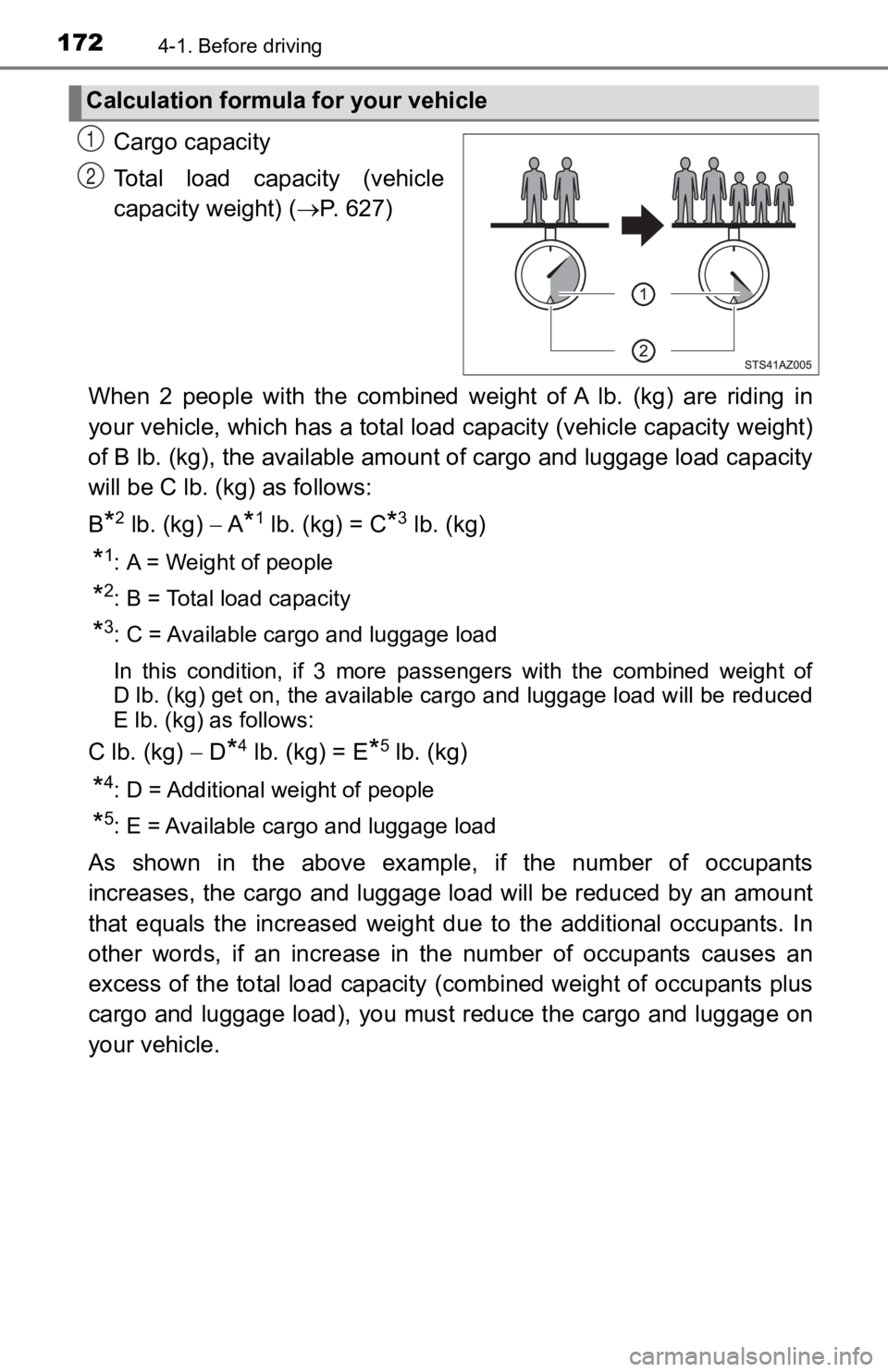
1724-1. Before driving
Cargo capacity
Total load capacity (vehicle
capacity weight) (P. 627)
When 2 people with the combined weight of A lb. (kg) are riding in
your vehicle, which has a total load capacity (vehicle capacity weight)
of B lb. (kg), the available amount of cargo and luggage load c apacity
will be C lb. (kg) as follows:
B
*2 lb. (kg) A*1 lb. (kg) = C*3 lb. (kg)
*1: A = Weight of people
*2: B = Total load capacity
*3: C = Available cargo and luggage load
In this condition, if 3 more passengers with the combined weigh t of
D lb. (kg) get on, the availabl e cargo and luggage load will be reduced
E lb. (kg) as follows:
C lb. (kg) D*4 lb. (kg) = E*5 lb. (kg)
*4: D = Additional weight of people
*5: E = Available cargo and luggage load
As shown in the above example, if the number of occupants
increases, the cargo and luggage load will be reduced by an amo unt
that equals the increased weight due to the additional occupant s. In
other words, if an increase in the number of occupants causes a n
excess of the total load capacity (combined weight of occupants plus
cargo and luggage load), you must reduce the cargo and luggage on
your vehicle.
Calculation formul a for your vehicle
1
2
Page 173 of 700

1734-1. Before driving
4
Driving
WARNING
■Things that must not be carried in the luggage compartment
The following things may cause a fire if loaded in the luggage compart-
ment:
●Receptacles containing gasoline
●Aerosol cans
■Storage precautions
Observe the following precautions.
Failure to do so may prevent the pedals from being depressed pr operly,
may block the driver’s vision, or may result in items hitting t he driver or
passengers, possibly causing an accident.
●Do not stack anything behind the front seats higher than the se at-
backs.
●Do not place cargo or luggage in or on the following locations.
• At the feet of the driver
• On the front passenger or rea r seats (when stacking items)
• On the instrument panel
• On the dashboard
• On the auxiliary box or tray that has no lid
●Secure all items in the occupant compartment.
●Never allow anyone to ride in the rear deck. It is not designed for pas-
sengers. They should ride in their seats with their seat belts properly fastened.
■Capacity and distribution
●Do not exceed the maximum axle weight rating or the total vehic le
weight rating.
●Even if the total load of occupant’s weight and the cargo load is less
than the total load capacity, do not apply the load unevenly. I mproper
loading may cause deterioration of steering or braking control which
may cause death or serious injury.
Page 174 of 700
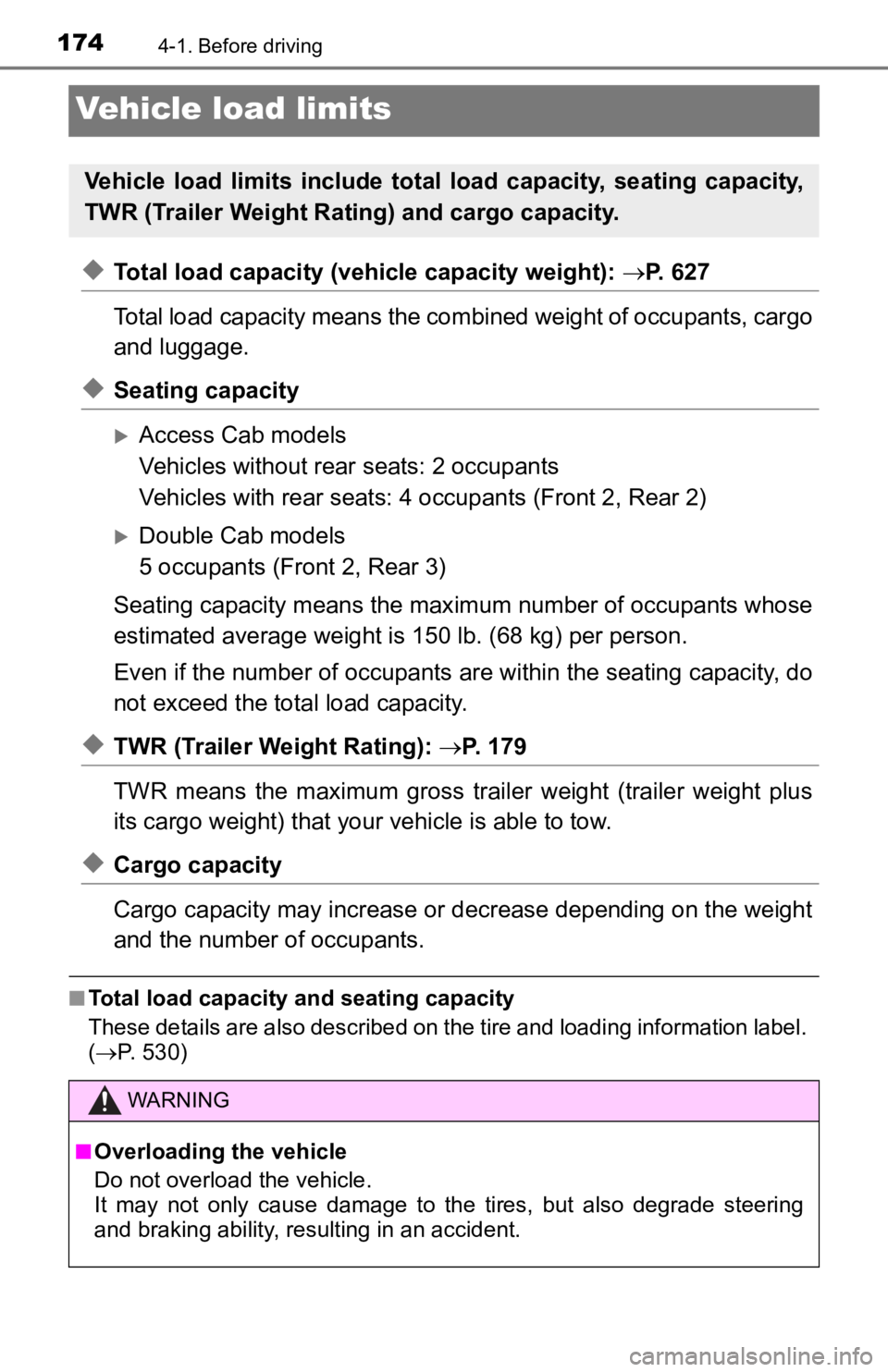
1744-1. Before driving
Vehicle load limits
◆Total load capacity (vehicle capacity weight): P. 627
Total load capacity means the co mbined weight of occupants, cargo
and luggage.
◆Seating capacity
Access Cab models
Vehicles without rear seats: 2 occupants
Vehicles with rear seats: 4 occupants (Front 2, Rear 2)
Double Cab models
5 occupants (Front 2, Rear 3)
Seating capacity means the max imum number of occupants whose
estimated average weight is 150 lb. (68 kg) per person.
Even if the number of occupants are within the seating capacity , do
not exceed the tota l load capacity.
◆TWR (Trailer Weight Rating): P. 179
TWR means the maximum gross trai ler weight (trailer weight plus
its cargo weight) that your vehicle is able to tow.
◆Cargo capacity
Cargo capacity may increase or decrease depending on the weight
and the number of occupants.
■Total load capacity and seating capacity
These details are also described on the tire and loading information label.
( P. 530)
Vehicle load limits include total load capacity, seating capaci t y,
TWR (Trailer Weight Rati ng) and cargo capacity.
WARNING
■
Overloading the vehicle
Do not overload the vehicle.
It may not only cause damage to the tires, but also degrade steering
and braking ability, resulting in an accident.
Page 175 of 700
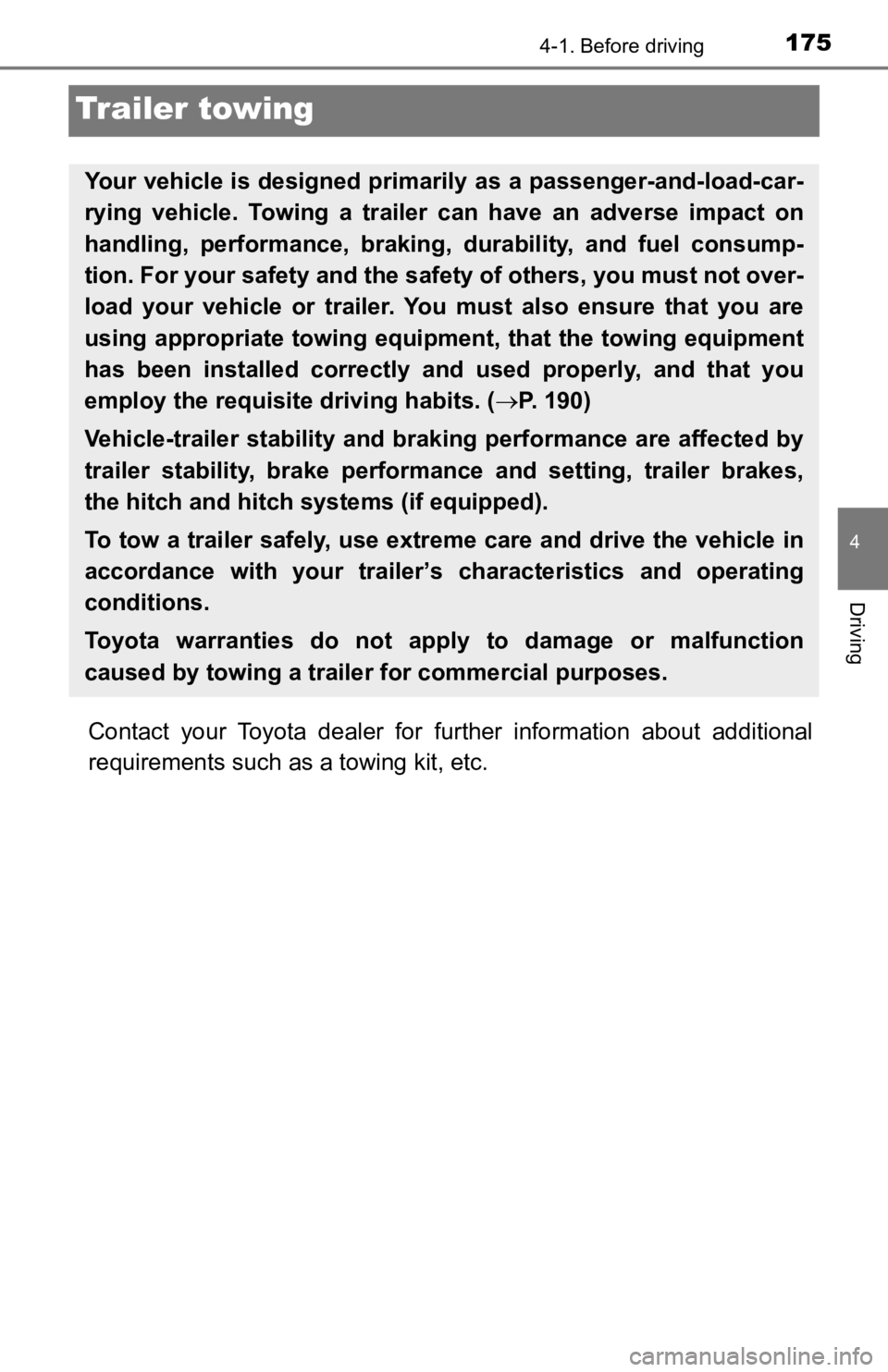
1754-1. Before driving
4
Driving
Trailer towing
Contact your Toyota dealer for further information about additi onal
requirements such as a towing kit, etc.
Your vehicle is designed primarily as a passenger-and-load-car-
rying vehicle. Towing a trailer can have an adverse impact on
handling, performance, braking, durability, and fuel consump-
tion. For your safety and the safety of others, you must not ov er-
load your vehicle or trailer. You must also ensure that you are
using appropriate towing equipm ent, that the towing equipment
has been installed correctly a nd used properly, and that you
employ the requisite driving habits. (P. 190)
Vehicle-trailer stability and braking performance are affected by
trailer stability, brake performance and setting, trailer brake s,
the hitch and hitch systems (if equipped).
To tow a trailer safely, use extreme care and drive the vehicle in
accordance with your trailer’s characteristics and operating
conditions.
Toyota warranties do not apply to damage or malfunction
caused by towing a trailer for commercial purposes.
Page 176 of 700
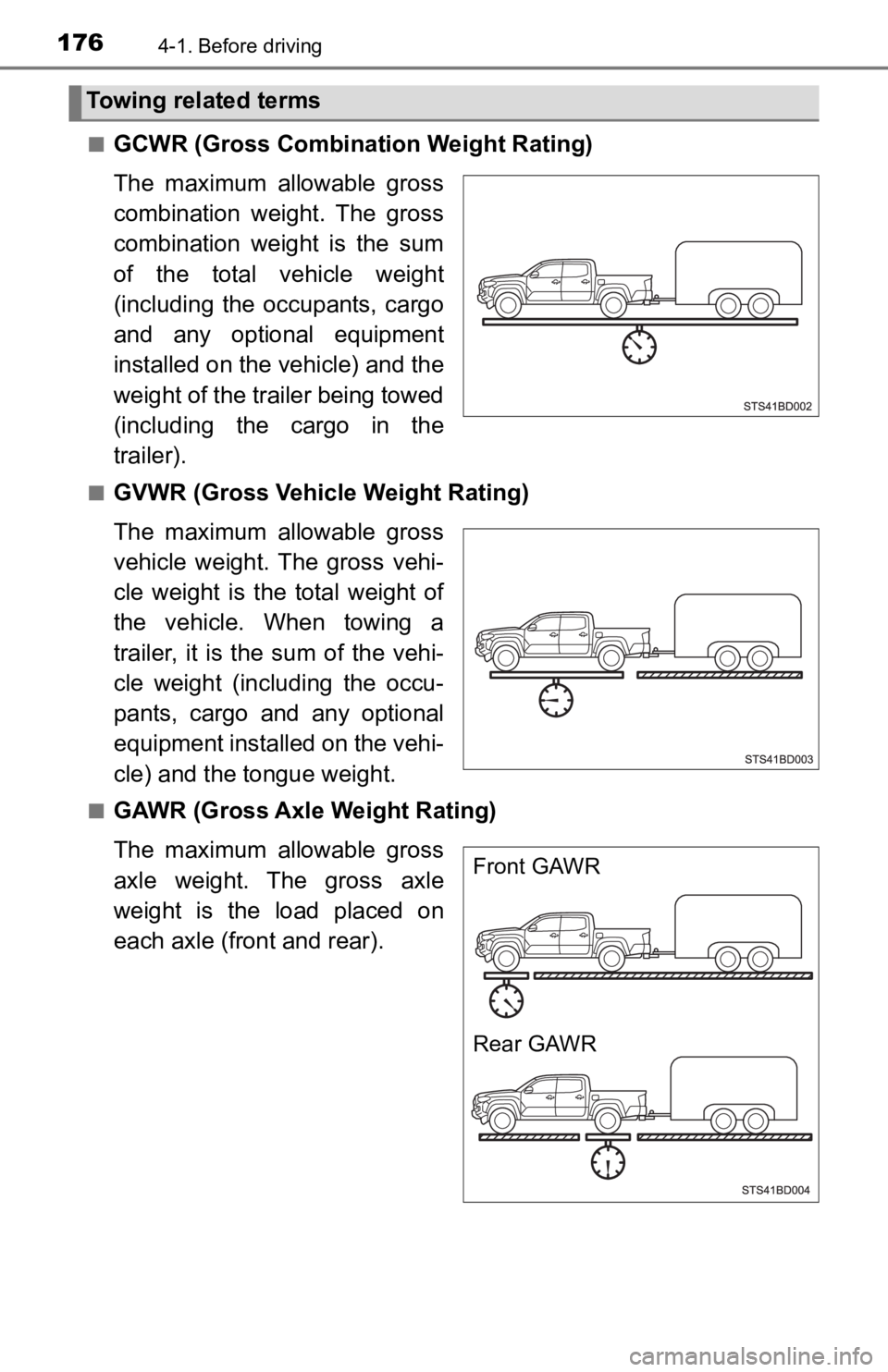
1764-1. Before driving
■GCWR (Gross Combination Weight Rating)
The maximum allowable gross
combination weight. The gross
combination weight is the sum
of the total vehicle weight
(including the occupants, cargo
and any optional equipment
installed on the vehicle) and the
weight of the trailer being towed
(including the cargo in the
trailer).
■GVWR (Gross Vehicle Weight Rating)
The maximum allowable gross
vehicle weight. The gross vehi-
cle weight is the total weight of
the vehicle. When towing a
trailer, it is the sum of the vehi-
cle weight (including the occu-
pants, cargo and any optional
equipment installed on the vehi-
cle) and the tongue weight.
■GAWR (Gross Axle Weight Rating)
The maximum allowable gross
axle weight. The gross axle
weight is the load placed on
each axle (front and rear).
Towing related terms
Front GAWR
Rear GAWR
Page 177 of 700
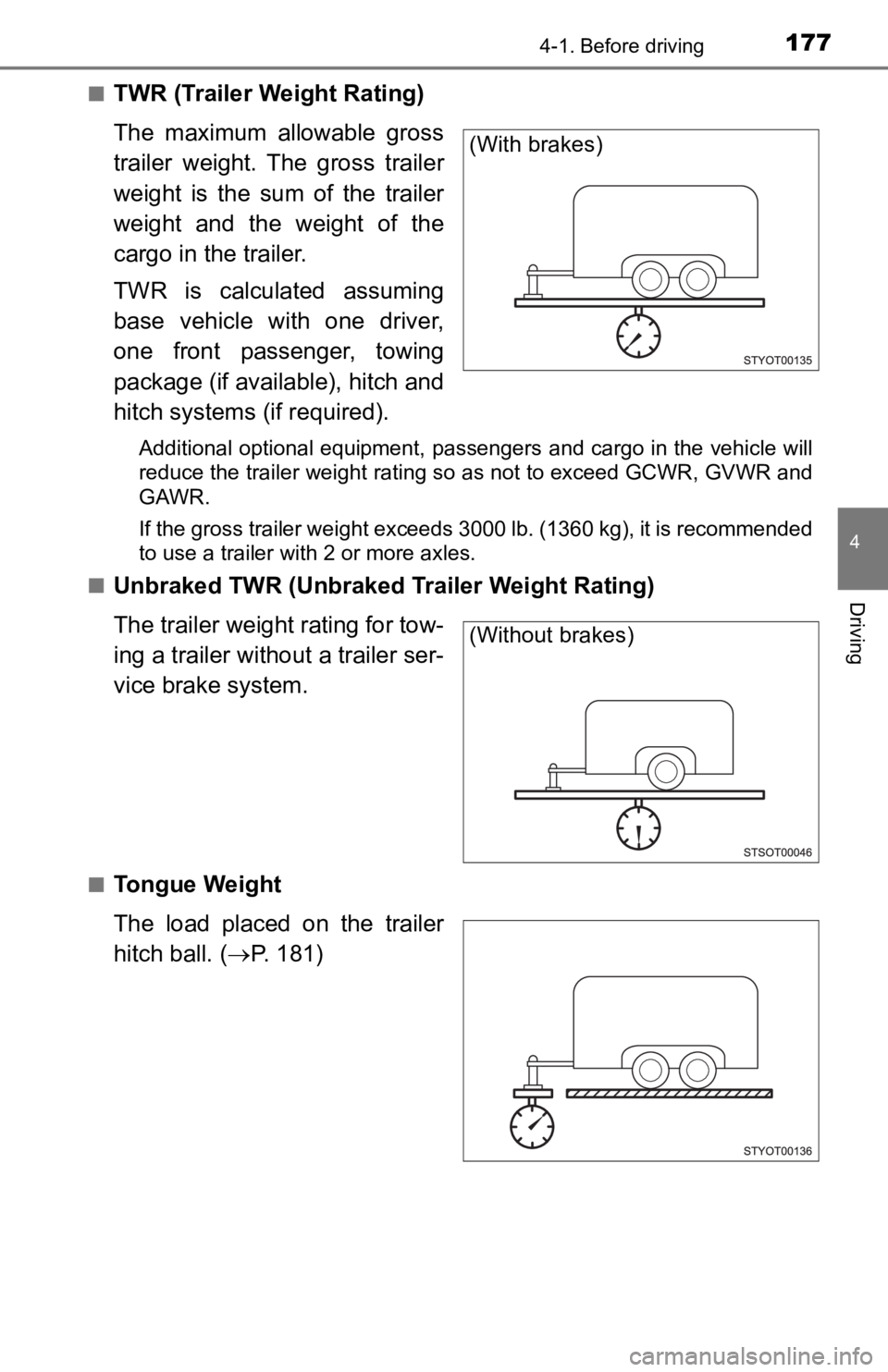
1774-1. Before driving
4
Driving
■TWR (Trailer Weight Rating)
The maximum allowable gross
trailer weight. The gross trailer
weight is the sum of the trailer
weight and the weight of the
cargo in the trailer.
TWR is calculated assuming
base vehicle with one driver,
one front passenger, towing
package (if available), hitch and
hitch systems (if required).
Additional optional equipment, passengers and cargo in the vehicle will
reduce the trailer weight rating so as not to exceed GCWR, GVWR and
GAWR.
If the gross trailer weight exceeds 3000 lb. (1360 kg), it is r ecommended
to use a trailer with 2 or more axles.
■
Unbraked TWR (Unbraked Trailer Weight Rating)
The trailer weight rating for tow-
ing a trailer without a trailer ser-
vice brake system.
■Tongue Weight
The load placed on the trailer
hitch ball. ( P. 181)
(With brakes)
(Without brakes)
Page 178 of 700
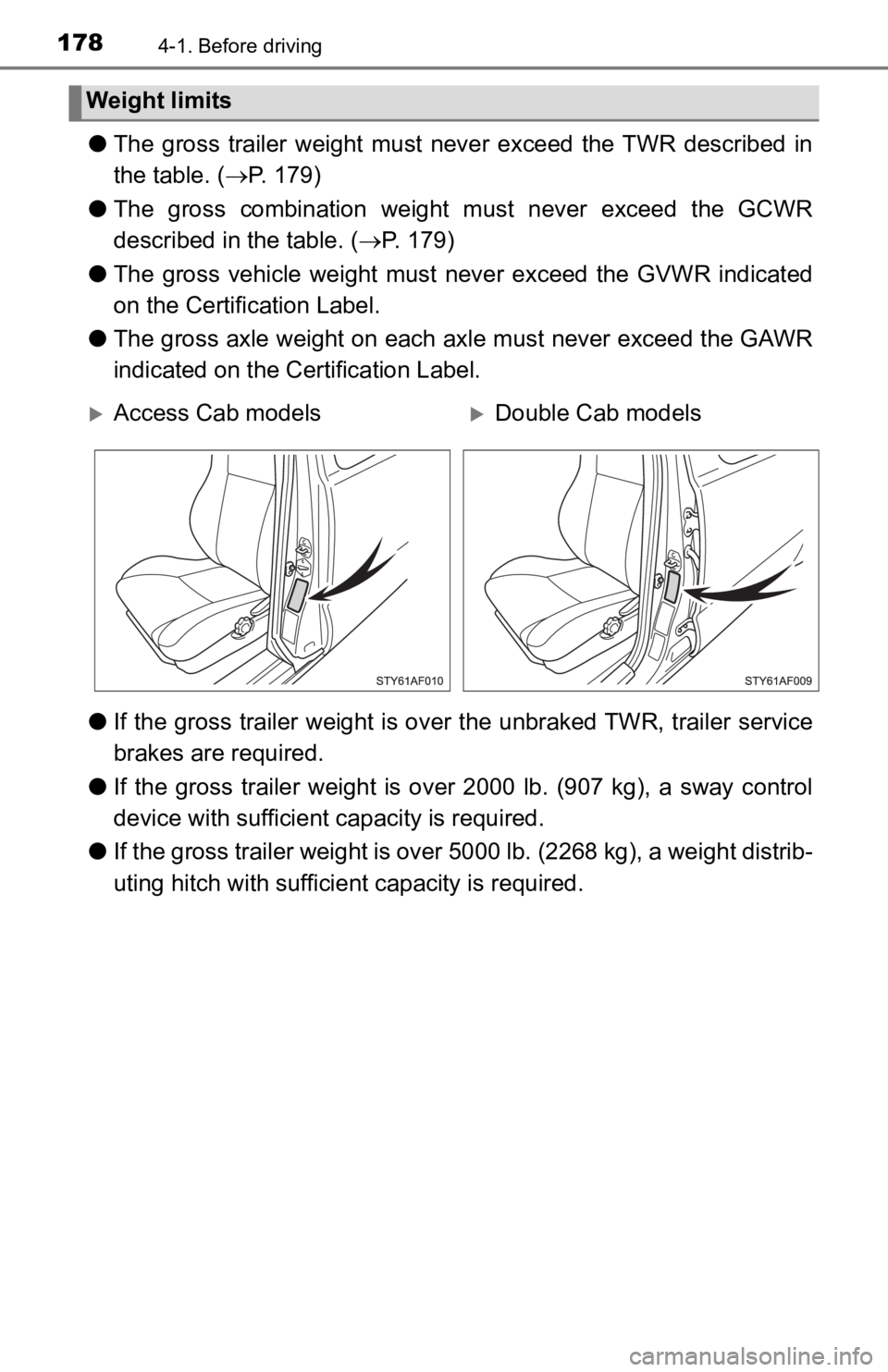
1784-1. Before driving
●The gross trailer weight must never exceed the TWR described in
the table. ( P. 1 7 9 )
● The gross combination weight must never exceed the GCWR
described in the table. ( P. 1 7 9 )
● The gross vehicle weight must never exceed the GVWR indicated
on the Certification Label.
● The gross axle weight on each axle must never exceed the GAWR
indicated on the Certification Label.
● If the gross trailer weight is over the unbraked TWR, trailer s ervice
brakes are required.
● If the gross trailer weight is over 2000 lb. (907 kg), a sway c ontrol
device with sufficient capacity is required.
● If the gross trailer weight is over 5000 lb. (2268 kg), a weigh t distrib-
uting hitch with suffici ent capacity is required.
Weight limits
Access Cab modelsDouble Cab models
Page 179 of 700
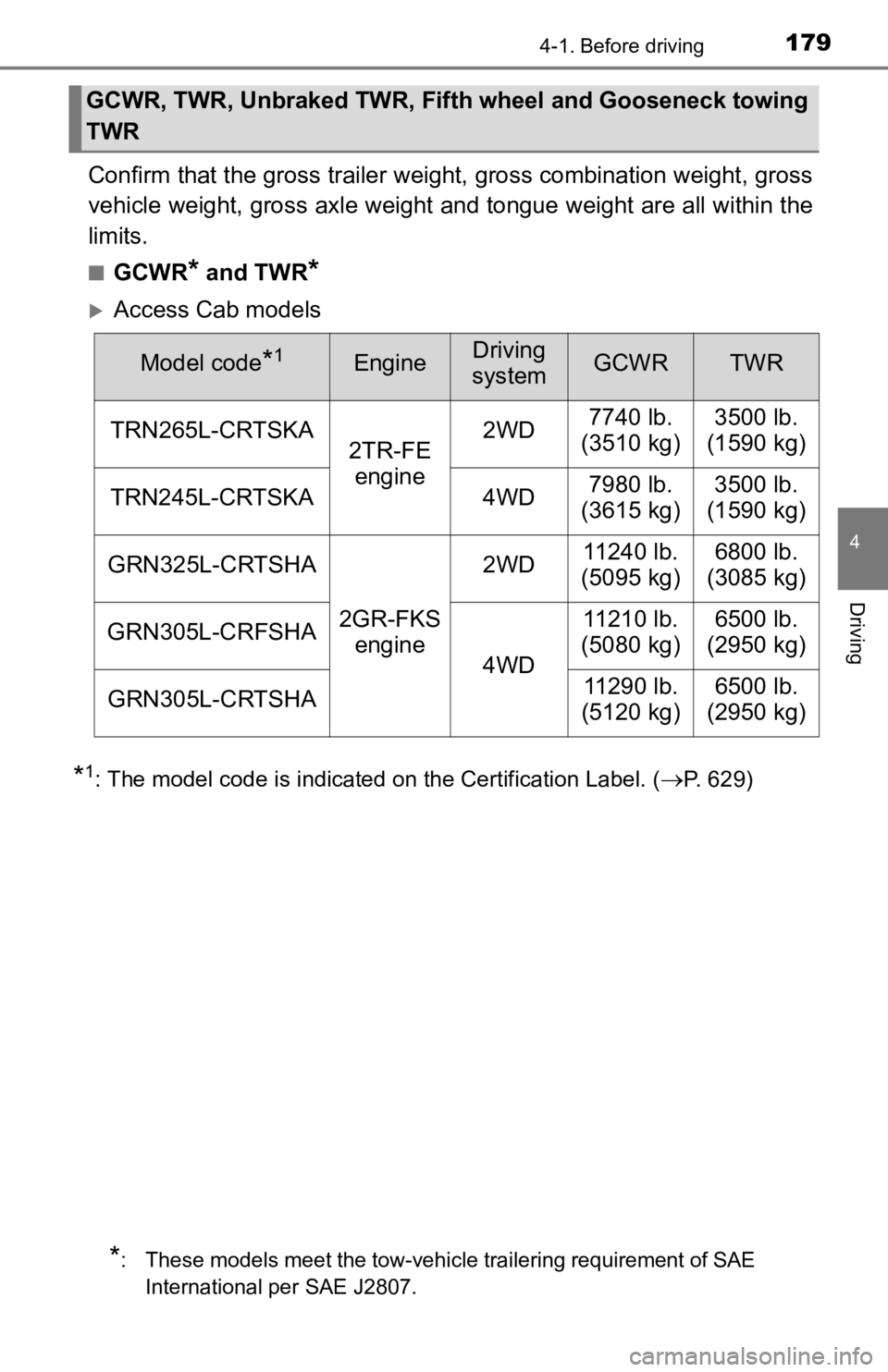
1794-1. Before driving
4
Driving
Confirm that the gross trailer weight, gross combination weight, gross
vehicle weight, gross axle weight and tongue weight are all within the
limits.
■GCWR* and TWR*
Access Cab models
*1: The model code is indicated on the Certification Label. (P. 629)
GCWR, TWR, Unbraked TWR, Fifth wheel and Gooseneck towing
TWR
*: These models meet the tow-vehicle trailering requirement of SAE International per SAE J2807.
Model code*1EngineDriving
systemGCWRTWR
TRN265L-CRTSKA 2TR-FE
engine 2WD
7740 lb.
(3510 kg) 3500 lb.
(1590 kg)
TRN245L-CRTSKA 4WD7980 lb.
(3615 kg) 3500 lb.
(1590 kg)
GRN325L-CRTSHA 2GR-FKS engine 2WD
11240 lb.
(5095 kg) 6800 lb.
(3085 kg)
GRN305L-CRFSHA 4WD11210 lb.
(5080 kg) 6500 lb.
(2950 kg)
GRN305L-CRTSHA 11290 lb.
(5120 kg) 6500 lb.
(2950 kg)
Page 180 of 700
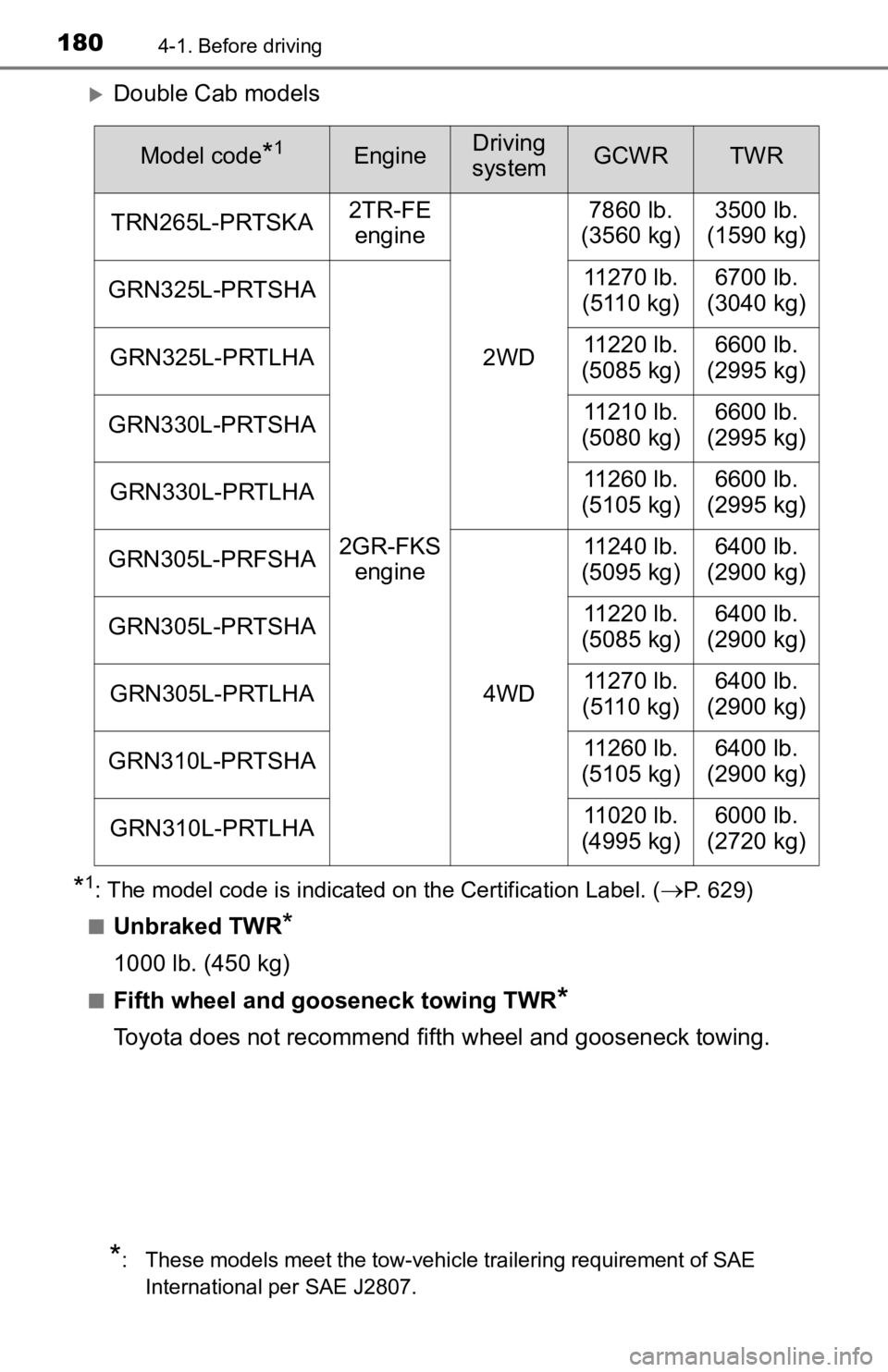
1804-1. Before driving
Double Cab models
*1: The model code is indicated on the Certification Label. (P. 629)
■Unbraked TWR*
1000 lb. (450 kg)
■Fifth wheel and gooseneck towing TWR*
Toyota does not recommend fifth wheel and gooseneck towing.
Model code*1EngineDriving
systemGCWRTWR
TRN265L-PRTSKA 2TR-FE
engine
2WD7860 lb.
(3560 kg) 3500 lb.
(1590 kg)
GRN325L-PRTSHA
2GR-FKS engine 11270 lb.
(5110 kg)
6700 lb.
(3040 kg)
GRN325L-PRTLHA 11220 lb.
(5085 kg)6600 lb.
(2995 kg)
GRN330L-PRTSHA 11210 lb.
(5080 kg)6600 lb.
(2995 kg)
GRN330L-PRTLHA 11260 lb.
(5105 kg)6600 lb.
(2995 kg)
GRN305L-PRFSHA
4WD11240 lb.
(5095 kg)
6400 lb.
(2900 kg)
GRN305L-PRTSHA 11220 lb.
(5085 kg)6400 lb.
(2900 kg)
GRN305L-PRTLHA 11270 lb.
(5110 kg)6400 lb.
(2900 kg)
GRN310L-PRTSHA 11260 lb.
(5105 kg)6400 lb.
(2900 kg)
GRN310L-PRTLHA 11020 lb.
(4995 kg)6000 lb.
(2720 kg)
*: These models meet the tow-vehicle trailering requirement of SAE
International per SAE J2807.